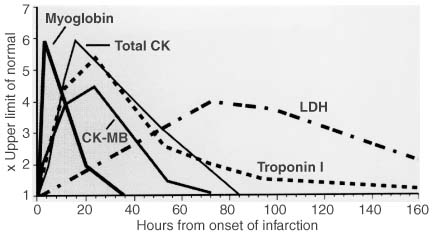 |
 |
Figure 50-6
Time course of elevations in serum markers after acute
myocardial infarction (AMI). This figure summarizes the relative timing, rate of
rise, peak values, and duration of elevation above the upper limit of normal for
multiple serum markers after AMI. Although total creatine kinase (CK), CK-MB, and
lactate dehydrogenase (LDH [with isoenzymes]) are traditionally measured, the relatively
slow rate of rise above normal for CK and the potential confusion with noncardiac
sources of enzyme release for both total CK and LDH have inspired the search for
additional serum markers. The smaller molecule myoglobin is released quickly from
infarcted myocardium but is not cardiac specific. Therefore, elevations in myoglobin
that may be detected quite early after the onset of infarction require confirmation
with a more cardiac-specific marker such as CK-MB or troponin I. Troponin I (and
troponin T, not shown) rises more slowly than myoglobin does and may be useful for
diagnosis of infarction even up to 3 to 4 days after the event. Monoclonal antibody
assays for cardiac-specific troponin I and troponin T are now available. (From
Antman EM: General hospital management. In Julian
DG, Braunwald E [eds]: Management of Acute Myocardial Infarction. London, WB Saunders,
1994.)

 |
